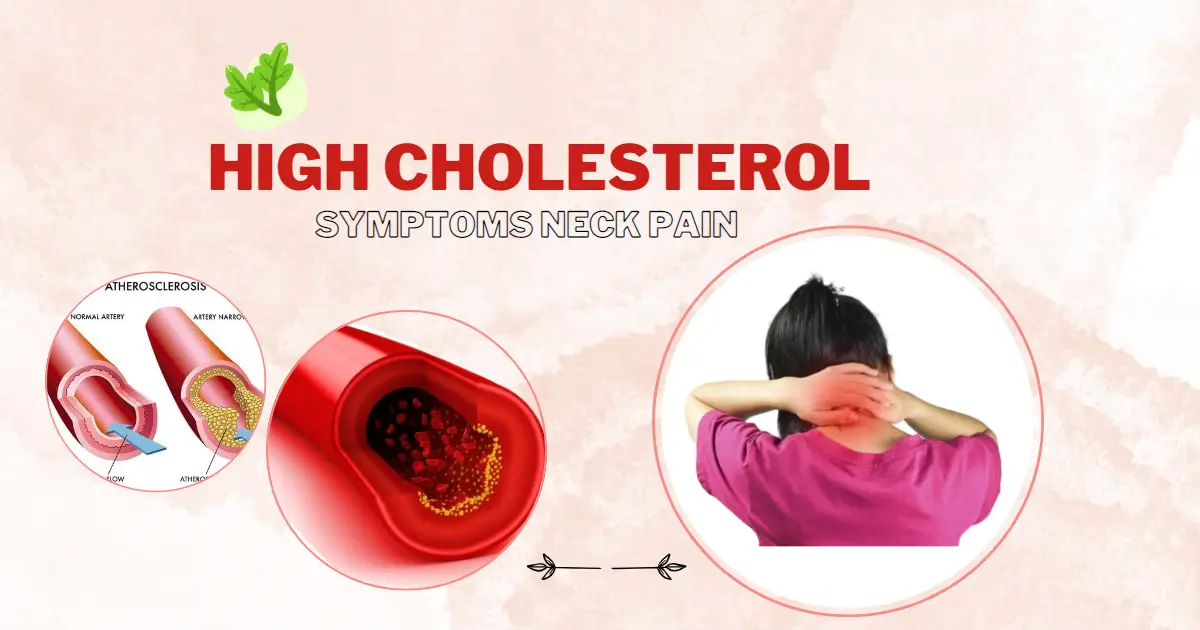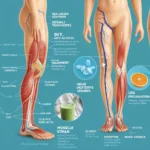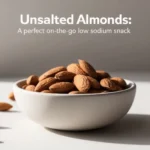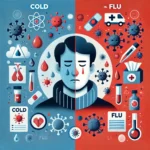Neck pain or silent alarm? Uncovering the Secret Connection of High Cholesterol Symptoms Neck Pain.
I. High Cholesterol Symptoms Neck Pain.
Introduction
A common health problem impacting millions of people globally is high cholesterol. Although it is frequently linked to cardiovascular issues, an intriguing connection—neck pain as a possible sign of elevated cholesterol—remains largely unexplored. This paper analyses the unexpected relationship between high cholesterol and neck pain, highlighting this unnoticed symptom.
What is High Cholesterol?
To comprehend the correlation between high cholesterol and neck pain, grasping the concept of high cholesterol is imperative. Cholesterol, a waxy substance in your blood, is vital in building healthy cells and producing essential hormones. However, cholesterol levels exceeding the normal range can pose significant health risks.
High cholesterol, also known as hypercholesterolemia, arises when low-density lipoprotein (LDL) cholesterol, sometimes known as “bad” cholesterol, develops abnormally in the arteries.
-
An unexpected connection: neck pain as a symptom of high cholesterol
Pain in the neck is often an issue that can be cured due to various underlying reasons, such as an injury, bad posture, an ailment, and stress. The fact that neck pain might be more demanding than that might surprise you. Even though it is not the most typical or well-known manifestation, the neck offers valuable insight into a person’s cardiovascular health.
This post will discuss the connection between neck pain and high cholesterol, examine the underlying causes, and discuss effective treatment options.
-
The surprising connection between neck pain
Recent studies have highlighted the surprising connection between neck pain and high cholesterol. According to research, having excessive cholesterol causes atherosclerosis, which affects the blood vessels lining the neck. Atherosclerosis causes the arteries that carry vital nutrients and oxygen to the neck region to constrict, resulting in discomfort and stiffness.
As these veins get more constricted, they prevent enough blood flow to the neck, causing discomfort and agony.
Furthermore, the reduced blood supply to the neck muscles may lead to inflammation, exacerbating neck pain severity.
-
Link Between Neck Pain and High Cholesterol
While neck pain is not a widely recognized symptom of high cholesterol, there are plausible explanations for the connection between the two conditions. Understanding these mechanisms can help identify and address the underlying causes of neck pain in individuals with high cholesterol.
* Restricted Blood Flow- Atherosclerosis is a condition where plaque builds up in the arteries due to high cholesterol levels. This plaque buildup can limit blood flow to various body parts, including the neck. Reduced blood flow to the neck muscles and surrounding tissues can cause pain and discomfort.
* Nerve Compression- Plaque buildup in the arteries can also pressure nearby nerves, leading to nerve compression. When nerves in the neck region are compressed or irritated, it can result in neck pain that spreads to the shoulders and arms. This pain may be experienced as a result of high cholesterol-related complications.
* Inflammation- Chronic inflammation is another factor that can contribute to both high cholesterol and neck pain. High cholesterol levels can trigger inflammation in the arteries, further narrowing the blood vessels and impeding blood flow. Inflammation in the neck area can manifest as pain and stiffness.
II. Understanding High Cholesterol
Neck pain, a prevalent ailment, can arise from various causes, such as muscle strain, poor posture, or underlying medical conditions. It manifests as discomfort or stiffness in the neck region and may extend to the shoulders and upper back. While neck pain is commonly associated with musculoskeletal issues, it can also indicate an underlying health concern, including high cholesterol.
Let’s first define high cholesterol better to understand the relationship between it and neck pain. A waxy substance called cholesterol is produced by the liver and obtained through certain foods, and it is essential for many body processes, including synthesizing hormones and forming cell membranes. Two lipoproteins, low-density lipoprotein (LDL) and high-density lipoprotein (HDL) carry cholesterol through the blood.
Because it can build up in the arteries and cause plaque and potential blockages, The term “bad” or” LDL cholesterol” is used frequently. Good cholesterol, or HDL, on the other hand, is regarded as “good” cholesterol since it helps in getting rid of additional cholesterol from the circulation.
-
Defining Cholesterol and its Role in the Body
A waxy molecule usually produced by the liver, some foods also include cholesterol. It is essential for various bodily functions, including the production of hormones, vitamin D synthesis, and the formation of cell membranes. However, when cholesterol levels become excessive, it can lead to health problems
-
Differentiating between HDL and LDL cholesterol
High-density lipoproteins (HDL) and low-density lipoproteins (LDL) are two types of lipoproteins that transport cholesterol in the blood. The reason HDL cholesterol is sometimes referred to as “good cholesterol” is that it aids in the removal of extra cholesterol from the bloodstream and the transportation of that cholesterol back to the liver for processing and disposal. LDL cholesterol, on the other hand, is referred to as “bad cholesterol” because it can cause plaque to form in the arteries and raise the risk of heart disease.

-
Understanding atherosclerosis and its connection to neck pain
Atherosclerosis is a complex process involving gradually accumulating cholesterol, fatty substances, cellular debris, and calcium within the arterial walls. Over time, this buildup forms plaques, causing the arteries to become narrow and less flexible. While atherosclerosis typically affects significant arteries, such as those supplying the heart, it can also affect the carotid arteries in the neck.
The brain and head receive oxygen-rich blood from the carotid arteries. When these arteries shrink or become clogged due to plaque formation, it can reduce blood flow and oxygen supply to the neck muscles and surrounding tissues, resulting in neck pain.
III. Unraveling the Complexity of Neck Pain
Common ailments like neck pain significantly affect daily life and well-being. Examining the numerous causes of neck pain, the function of inflammation, and the point at which it becomes a chronic illness are critical to understanding the complexities of this problem.
-
Exploring the various causes of neck pain
Neck pain can arise from a variety of factors, including:
- Muscle Strain: Poor posture, repetitive movements, or overuse of the neck muscles can lead to muscle strain and subsequent pain.
- Poor Ergonomics: Incorrect workstation setups, such as improper chair height or computer screen position, can strain the neck muscles and cause discomfort.
- Injury or Trauma: Whiplash resulting from car accidents, sports injuries, or falls can cause neck pain due to damage to the muscles, ligaments, or discs in the neck.
- Degenerative Conditions: Conditions such as osteoarthritis, cervical spondylosis, or herniated discs can cause neck pain as the structures in the neck degenerate over time.
- Nerve Compression: Pinched nerves, such as cervical radiculopathy, can cause radiating neck pain that extends into the shoulder, arm, or hand.
-
The Role of Inflammation in neck pain
The development of chronic illnesses and the feeling of pain are both influenced by inflammation, which also plays a significant role in neck discomfort. Injury or stress to the neck can naturally result in inflammation, which can cause discomfort and chronic problems. Chemical mediators are released in this process, stimulating nerve endings to send pain signals to the brain. Chronic inflammation can also release enzymes that degrade tissue, resulting in more harm and discomfort.
-
Identifying when neck pain becomes chronic
Neck pain is considered chronic when it persists for more than three months. Chronic neck pain can significantly impact the quality of life, leading to physical limitations, emotional distress, and decreased productivity.
Some signs that neck pain may be transitioning into a chronic condition include:
- Persistent Pain: The pain persists beyond the expected healing time and does not improve with conventional treatments or rest.
- Radiating Pain: The pain radiates to other areas, such as the shoulders, arms, or head, indicating possible nerve involvement.
- Limited Range of Motion: Difficulty moving the neck entirely or experiencing stiffness restricting regular neck movements.
- Psychological Factors: The presence of anxiety, depression, or increased stress levels can contribute to the perception and amplification of neck pain.
It’s critical to seek medical examination and treatment when neck pain develops into a chronic condition. To address the underlying reasons and alleviate pain, a healthcare professional can perform a complete assessment, request diagnostic tests if needed, and create an individualized treatment plan.
IV. The Hidden Symptoms of High Cholesterol
High cholesterol is often called the “silent killer” because it doesn’t typically manifest apparent symptoms. However, hidden signs can indicate elevated cholesterol levels, and it is essential to recognize these symptoms for early detection and proactive therapy. In addition to the commonly associated cardiovascular symptoms, there are surprising signs beyond the cardiovascular system that can be linked to high cholesterol. One emerging revelation is the potential connection between neck pain and high cholesterol.
-
Recognizing common symptoms of high cholesterol
Recognizing the symptoms of neck pain caused by high cholesterol is essential for early detection and prompt intervention. Common symptoms associated with high cholesterol include neck pain, swollen lymph nodes, and difficulty breathing. High cholesterol itself may not produce noticeable symptoms, but it can contribute to other conditions that do. Some common symptoms associated with high cholesterol include:
1. Radiating pain from the neck to the shoulders and arms- As mentioned earlier, neck pain occurs due to reduce blood flow to the neck muscles caused by atherosclerosis. This pain may be a dull ache or a sharp, shooting pain.
2. Arms or hands tingling or numb- High cholesterol can sometimes lead to peripheral neuropathy, causing numbness and tingling sensations in the body’s hands, feet, or other areas.
3. Headaches and Migraines, especially in the back of the head- High cholesterol levels can cause headaches and migraines, which may occur frequently or become more severe. Other symptoms, such as dizziness or nausea, often accompany these headaches.
4. Dizziness or lightheadedness- The blood flow to the brain can be disrupted by cholesterol buildup in the arteries, which can cause vertigo and dizziness.
5. Fatigue or Weakness: High cholesterol can impede proper blood flow throughout the body, leading to feelings of tiredness and reduced energy levels.
Reduced blood flow caused by high cholesterol can deprive the neck muscles of the necessary oxygen and nutrients, leading to fatigue and weakness. If you notice persistent fatigue or weakness, it is crucial to consider cholesterol levels as a potential cause.
6. Shortness of Breath: Reduced blood flow to the heart can cause a feeling of breathlessness, especially during physical exertion or exercise.
In some cases, high cholesterol can contribute to the development of cardiovascular problems, such as heart disease. If neck pain is accompanied by unexplained shortness of breath, seeking medical attention promptly to rule out any underlying severe conditions is essential.
7. Jaw Pain- High cholesterol can contribute to plaque development in the arteries near the heart. This plaque buildup can sometimes cause jaw pain, especially during physical exertion or emotional stress.
8. Chest Pain: Chest pain, also known as angina, can occur when the arteries supplying the heart become narrowed due to cholesterol plaque buildup.
9. Leg Pain: Reduced blood flow to the legs due to narrowed arteries, a condition called peripheral artery disease, can result in leg pain or cramping during physical activity.

V. Detecting High Cholesterol and Neck Pain
Healthcare professionals must use a holistic approach to diagnose high cholesterol and neck pain, using tests and exams to identify possible correlations and ensure a thorough diagnosis. It is essential due to overlapping symptoms that may occur.
-
Diagnostic methods for high cholesterol assessment
To assess cholesterol levels, healthcare professionals utilize various diagnostic methods, including:
Lipid Profile: A lipid profile evaluates the blood’s triglyceride, LDL, HDL, and total cholesterol levels. This blood test gives a comprehensive evaluation of a person’s cholesterol profile.
Non-HDL Cholesterol: Non-HDL cholesterol includes all cholesterol except HDL cholesterol. It provides valuable information about the risk of developing cardiovascular diseases associated with high cholesterol levels.
Fasting Cholesterol Test: This test requires fasting for a specific duration before blood sample collection. It provides accurate measurements of total cholesterol and triglyceride levels.
Advanced Lipoprotein Testing: Advanced lipoprotein testing assesses specific lipoprotein particles and their subclasses, providing a more detailed analysis of an individual’s cholesterol profile.
These diagnostic methods help healthcare professionals determine an individual’s cholesterol status and evaluate the need for further management and treatment.
-
Evaluating neck pain: tests and examinations
To evaluate neck pain, healthcare professionals employ various tests and examinations, including:
1. Physical Examination: A thorough physical examination allows healthcare professionals to assess neck mobility, identify tender areas, and evaluate muscle strength and sensation.
2. Imaging Tests: To evaluate the neck’s structural integrity, spot abnormalities, and rule out problems like herniated discs or spinal stenosis, imaging procedures like X-rays, CT scans, or MRI scans may be advised.
3. Nerve Studies: Nerve conduction studies (NCS) and electromyography (EMG) can assess nerve function and find any probable nerve damage or compression causing neck pain.
4. Laboratory Tests: In some cases, laboratory tests such as blood tests or inflammatory marker assessments may be ordered to identify underlying causes of neck pain, including conditions associated with high cholesterol.
VI. Lifestyle Modifications to Address High Cholesterol and Neck Pain
To address high cholesterol and neck pain, here are some lifestyle modifications you can consider:
- Healthy Diet:
- Increase your intake of fruits and vegetables, wholesome grains, and lean proteins.
- Limit the consumption of saturated fats and trans fats found in fried and processed foods.
- Reduce your intake of cholesterol-rich foods like red meat, full-fat dairy products, and egg yolks.
- Choose healthy cooking methods, including grilling, baking, steaming, or sautéing with little to no oil.
- Regular Exercise:
- Regular physical activity, like jogging, cycling, swimming, or brisk walking, is advised.
- Aim for 75 minutes of intense or 150 minutes of moderate aerobic exercise to a high level each week.
- Incorporate strength training exercises to improve muscle tone and overall fitness.
- Weight Management:
- You may maintain your weight or work towards achieving a healthy weight by consuming a balanced diet and engaging in regular exercise.
- Reduced neck and joint strain and decreased cholesterol levels can also result from weight loss.
- Quit Smoking:
- If you smoke, quitting is essential, as smoking can raise cholesterol levels and worsen neck pain.
- Seek support from healthcare professionals, support groups, or smoking cessation programs to stop successfully.
- Stress Management:
- Practice stress-reducing techniques such as deep breathing exercises, meditation, or yoga.
- Engage in activities you enjoy to relax and unwind, such as reading, listening to music, or spending time with loved ones.
- Posture and Ergonomics:
- To reduce neck tension, maintain excellent posture while standing, sitting, and sleeping.
- Adjust your workstation ergonomics to ensure proper alignment of the neck and spine.
- Stretching and Strengthening Exercises:
- Perform neck stretches and strengthening exercises recommended by a healthcare professional or physical therapist.
- Avoid excessive neck movements or positions that worsen the pain.
- Regular Checkups:
- Set up routine checkups with your doctor to monitor your cholesterol levels and review any neck pain problems.
- Follow their recommendations for medication if prescribed.
Remember, consulting with a healthcare professional for personalized advice and guidance tailored to your condition is essential.
-
Diet and nutrition: critical considerations for cholesterol management

When it comes to managing cholesterol through diet and nutrition, here are some key considerations:
- Reduce Saturated and Trans Fats:
- Reduce the consumption of foods high in saturated fats, such as fatty meat, whole milk, dairy products, and tropical oils (coconut oil, palm oil).
- Avoid trans fats in processed and fried foods, such as packaged snacks, baked goods, and fast food.
- Choose Healthy Fats:
- Choose monounsaturated (olive oil, avocados, and almonds) and polyunsaturated (fatty fish, flaxseeds, and walnuts) sources of fat instead.
- Include omega-3 fatty acids from salmon, mackerel, sardines, and chia seeds, which have heart-healthy benefits.
- Increase Soluble Fiber Intake:
- Consuming soluble fiber-rich foods can help decrease cholesterol levels. Include sources like oats, barley, legumes, fruits (such as apples, citrus fruits, and berries), and vegetables (such as broccoli and Brussels sprouts) in your diet.
- Consume Plant Sterols and Stanols:
- Stanols and plant sterols are substances that can reduce LDL cholesterol. They are naturally present in small amounts in certain plant-based foods but are also available as supplements or added to certain fortified foods like margarine.
- Include Lean Proteins:
- Choose lean protein sources such as tofu, skinless poultry, fish, and lentils.
- Limit the consumption of high-fat meats and processed meats like sausages and bacon.
- Increase Consumption of Fruits and Vegetables:
- Make an effort to include a range of fruit and vegetable varieties in your diet.
- They contain many minerals and antioxidants that support heart health while having few calories.
- Choose Whole Grains:
- Choose whole grain items instead, such as whole wheat bread, brown rice, quinoa, and cereals.
- They contain more fiber and nutrients compared to refined grains.
- Limit Added Sugars and Refined Carbohydrates:
- Reduce your intake of sugary beverages, sweets, and processed foods high in added sugars.
- Instead of refined carbohydrates, choose complex ones because, on blood sugar levels, they have less of an impact. Whole grains, sweet potatoes, and legumes are a few examples.
- Practice Portion Control:
- Pay attention to portion size to avoid overeating, which can lead to weight gain and elevated cholesterol levels.
- Use smaller plates and bowls, and listen to your body’s hunger and fullness cues.
- Stay Hydrated:
- Keep yourself hydrated and support general health by drinking enough daily water.
Work with a medical expert or certified dietician to develop a healthy eating plan that meets your cholesterol goals. Based on your particular health status, they can offer specific recommendations.
-
Exercise and physical activity: improving cardiovascular health and neck pain
Exercise and physical activity can improve cardiovascular health and manage neck pain. Here are some considerations:
Aerobic Exercise:
-
- Engage in aerobic activities such as brisk walking, jogging, cycling, swimming, or dancing.
- Set a weekly goal of 75 minutes of vigorous or 150 minutes of moderate aerobic activity.
- Aerobic exercise helps improve cardiovascular health by strengthening the heart and improving blood circulation.
Strength Training:
-
- Incorporate strength training exercises at least two days a week.
- Focus on the neck, upper back, and shoulders, among other essential muscle groups.
- Strengthening the neck muscles can help improve neck pain and provide better support for the neck and spine.
Neck Exercises:
-
- Perform specific neck exercises recommended by a healthcare professional or physical therapist to strengthen and stretch the neck muscles.
- These exercises can help relieve neck pain and improve neck mobility.
Flexibility Exercises:
-
- Engage in stretching exercises to improve flexibility and reduce muscle tension.
- Include neck, shoulders, and upper back stretches to alleviate neck pain and improve posture.
Low-Impact Activities:
-
- Consider low-impact exercises like walking, swimming, or using an elliptical machine if you feel neck pain.
- These activities minimize strain on the neck while still providing cardiovascular benefits.
Posture Awareness:
-
- Maintain good posture during exercise and throughout the day.
- Avoid slouching or holding your neck in a forward position, as it can contribute to neck pain.
- Regularly connect the neck with the rest of your spine when exercising and doing your business.
Warm-Up and Cool-Down:
-
- Always start your exercise session with a proper warm-up to prepare your body for activity.
- Finish your workout with a cool-down routine that includes gentle stretches to help relax and lengthen the muscles.
Listen to Your Body:
-
- Pay attention to any discomfort or pain during exercise.
- Consult a healthcare professional for guidance if you experience worsening neck pain or other unusual symptoms.
Seek Professional Guidance:
-
- Consult a physician, like a physical therapist or exercise specialist, who can provide personalized advice and exercises tailored to your needs and conditions.
Remember to start gradually and progress at a pace that is comfortable for you. It’s essential to listen to your body, modify exercises as needed, and seek professional guidance when necessary.
-
Stress management techniques: their impact on cholesterol and neck pain
Stress management techniques can have a positive impact on both cholesterol levels and neck pain. Here’s how they can help:
Relaxation Techniques:
-
- Guided visualization, progressive muscular relaxation, and deep breathing techniques can all help people relax and feel less stressed.
- When stress levels decrease, the body’s cortisol (stress hormone) levels can normalize, positively impacting cholesterol levels.
Exercise and Physical Activity:
-
- Engaging in regular physical activity can help alleviate stress and improve mood.
- Endorphins are naturally occurring mood boosters that are released while you exercise.
- By managing stress through exercise, you may indirectly support healthy cholesterol levels and reduce the impact of neck pain.
Mindfulness and Meditation:
-
- Focusing on the present moment and accepting it without judgment are vital components of mindfulness meditation.
- Research suggests mindfulness can reduce stress, anxiety, and depression, indirectly influencing cholesterol levels and alleviating neck pain.
Yoga and Stretching:
-
- Yoga combines physical postures, breathing exercises, and meditation.
- Regular yoga exercise has been proven to reduce stress and enhance general wellness.
- Specific yoga poses and stretches can target neck pain and help improve posture and flexibility.
Social Support and Connection:
-
- Maintaining strong social connections and seeking support from loved ones can help reduce stress levels.
- Sharing concerns and experiences with others can provide emotional support and perspective, positively impacting cholesterol management and neck pain.
Time Management and Prioritization:
-
- Efficiently managing time and prioritizing tasks can reduce stress and create a sense of control.
- When stress levels are reduced, it can positively influence cholesterol levels and provide relief from neck pain.
VII. Complementary Approaches for Cholesterol and Neck Pain
Complementary approaches can be used with conventional medical treatments for managing cholesterol and neck pain. While these approaches may provide additional support, consulting with healthcare professionals before incorporating them into your treatment plan is essential. Here are some complementary strategies to consider:
Dietary Supplements:
-
- Omega-3 Fatty Acids: Fish oil supplements contain omega-3 fatty acids that may reduce triglyceride levels and improve cholesterol. Consult a healthcare professional for the appropriate dosage and quality of accessories.
- Plant Sterols and Stanols: These substances, available in supplement form, can help lower LDL cholesterol levels. They are often found in margarine or added to foods.
- Coenzyme Q10: Some studies suggest that CoQ10 supplements may help mitigate muscle-related side effects associated with statin use. Consult a healthcare professional for guidance.
Herbal Remedies:
-
- Red Yeast Rice: Derived from fermented rice, red yeast rice contains compounds that can help lower LDL cholesterol. However, it’s important to note that its active ingredient, monacolin K, is similar to lovastatin. Please consult a healthcare professional before using red yeast rice, as it may have similar side effects and drug interactions as statins.
- Turmeric: Turmeric’s primary component, curcumin, has anti-inflammatory qualities and may aid in the relief of neck pain. Both foods and supplements can contain it.
Mind-Body Practices:
-
- Meditation: Mindfulness meditation can reduce stress and promote overall well-being, potentially benefiting cholesterol management and reducing neck pain.
- Yoga: Yoga combines physical postures, breathing exercises, and meditation. Regular practice may improve flexibility, posture, and relaxation, potentially aiding cholesterol management and neck pain relief.
Acupuncture:
-
- Acupuncture is placing tiny needles into specific places on the body to create balance and pain relief. It may be used as an adjunct therapy for managing neck pain.
Chiropractic Care:
-
- Chiropractic adjustments and spinal manipulation may be used to address neck pain. This approach aims to improve joint mobility and reduce pain.
It’s essential to consult with a doctor if you use medication, have underlying medical conditions, or are pregnant or breastfeeding. They can offer guidance, evaluate potential interactions or contraindications, and support complementary therapies’ safe and efficient application.
-
Herbal supplements and their impact on cholesterol levels
Certain herbal supplements have been studied for their potential impact on cholesterol levels. While some herbs may positively affect cholesterol, it’s important to note that their efficacy and safety can vary. It’s recommended to consult with a healthcare professional before starting any herbal supplement. Here are some commonly studied herbs and their potential impact on cholesterol:
Red Yeast Rice:
-
- A fermented rice product is red yeast rice containing monacolin K, similar to the active ingredient in the statin drug lovastatin.
- Red yeast rice has been linked to reducing LDL cholesterol levels in studies.
- It’s important to note that red yeast rice may have similar side effects and interactions as statin medications, and a healthcare professional should monitor its use.
Garlic:
-
- Garlic has been studied for its potential cholesterol-lowering effects.
- According to some research, garlic may help lower total and LDL cholesterol levels.
- However, the evidence must be more conclusive, and the results may vary among individuals.
Artichoke Leaf Extract:
-
- Artichoke leaf extract has been investigated for its cholesterol-lowering properties.
- Research suggests that it may help reduce total cholesterol and LDL cholesterol levels.
- However, additional analysis is required to confirm the effectiveness of the treatment and find the most suitable dosages.
Green Tea:
-
- Catechins, which are found in green tea, have been investigated for their possible cardiovascular benefits.
- Some studies suggest that green tea catechins help reduce LDL cholesterol levels.
- However, the effects may vary, and more research is needed to understand the impact on cholesterol levels fully.
Psyllium:
-
- The husks of the Plantago ovate plant are the source of the soluble fiber known as psyllium.
- It can help lower LDL cholesterol levels when taken as a supplement or incorporated into the diet.
- Psyllium binds to cholesterol in the digestive tract, preventing absorption.
Herbal supplements can have adverse effects and interact with pharmaceuticals, so speaking to a medical expert before using them is essential. They can guide you on the best usage of herbal supplements and help you track their effect on cholesterol levels.
-
Alternative therapies to manage neck pain
There are alternative therapies that can be considered for managing neck pain. While their effectiveness may vary from person to person, some individuals find them beneficial. Seeking professional advice before implementing new therapies is crucial. Here are some alternative therapies for managing neck pain:
Acupuncture:
-
- Thin needles are inserted into specific body locations during acupuncture to relieve pain and improve overall well-being.
- It stimulates the body’s natural healing response and balances energy flow.
- Some people find acupuncture helpful in reducing neck pain and improving range of motion.
Chiropractic Care:
-
- Chiropractic care strongly emphasizes spinal adjustments and manipulation in diagnosing and treating musculoskeletal diseases.
- Chiropractors use manual techniques to address misalignments or joint dysfunction that may contribute to neck pain.
- Chiropractic care aims to improve joint mobility, reduce pain, and enhance overall spinal health.
Massage Therapy:
-
- During massage therapy, soft tissues are moved to promote relaxation, relieve muscle tension, and reduce pain.
- Therapists may use techniques such as Swedish massage, trigger point therapy, or deep tissue massage to specific areas of discomfort in the neck and surrounding muscles.
Transcutaneous Electrical Nerve Stimulation (TENS):
-
- TENS therapy involves a small, battery-operated device that delivers low-voltage electrical currents to the affected area via electrodes placed on the skin.
- Electrical stimulation can help reduce pain signals and promote muscle relaxation.
Mind-Body Practices:
-
- Neck discomfort can be relieved and tension reduced by meditation, mindfulness, and guided imagery.
- These practices focus on calming the mind and enhancing the mind-body connection, which may positively impact pain perception.
Heat or Cold Therapy:
-
- Neck pain might momentarily be relieved by applying heat or ice to the affected area.
- Heat therapy, such as a heating pad or warm compress, can help relax muscles and improve blood circulation.
- Ice packs or cold compresses, which are forms of cold therapy, can help numb the area and lessen swelling.
Alternative therapies should be used alongside conventional medical care and consulted with a healthcare professional to ensure safe and effective use.
-
Integrating holistic approaches with medical treatments
Integrating holistic approaches with medical treatments can provide a comprehensive and well-rounded approach to managing various health conditions. Holistic approaches consider the whole person—mind, body, and spirit—to promote overall well-being. Here are some ways to integrate holistic systems with medical treatments:
- Communication and Collaboration:
- Keep the lines of communication with your medical team—doctors, specialists, and complementary practitioners—open and honest.
- Share your interest in incorporating holistic approaches and discuss potential options that align with your medical treatment plan.
- Collaboration among healthcare professionals ensures that all aspects of your health are considered and coordinated.
- Mind-Body Techniques:
- Incorporate mind-body techniques, such as meditation, deep breathing exercises, or relaxation techniques, into your daily routine.
- These techniques can help reduce stress, improve mental well-being, and enhance the body’s natural healing abilities.
- Nutritional Support:
- Focusing on whole foods, including fruits and veggies, lean meats, and beneficial fats, is essential to maintain a healthy diet.
- Suppose you aim to attain your medical treatment objectives. In that case, it’s highly recommended to collaborate. Contact a registered dietitian or nutritionist who can provide helpful guidance. Establish a customized nutrition regimen tailored to your specific needs.
- Physical Activity:
- Engage in regular physical activity appropriate for your condition and fitness level.
- Consult with your healthcare professional or a qualified exercise specialist to develop an exercise plan that supports your overall health and complements your medical treatment.
- Complementary Therapies:
- Explore complementary therapies that may benefit your condition; examples of alternative treatments include acupuncture, massage therapy, and chiropractic care.
- Ensure that these therapies are provided by qualified and licensed practitioners who can work in coordination with your healthcare team.
- Stress Management:
- Develop stress management techniques tailored to your needs, such as participating in mindfulness practices, engaging in hobbies or activities you enjoy, or seeking support from a therapist or counselor.
- Chronic stress can impact overall health, so finding healthy ways to manage stress is essential.
- Emotional Support:
- To deal with emotional or psychological issues, seek moving help from friends, family, or support organizations—challenges related to your health condition.
- Emotional well-being plays a significant role in overall health and healing.
Combining holistic practices with medical therapies can create a more thorough and individualized approach to health and well-being. To ensure compatibility, informing all medical professionals involved in the care is critical.
VIII. Prevention and Risk Reduction
Prevention and risk reduction are essential for maintaining good health and reducing the chances of developing certain conditions. Here are some key strategies and practices to consider:
-
Lifestyle changes to prevent high cholesterol and neck pain
Maintain a Healthy Diet:
-
- Choose a balanced diet rich in fruits, vegetables, whole grains, lean proteins, and healthy fats.
- Reduce the consumption of trans and saturated fats, cholesterol, processed meals, sugary drinks, and salt.
- Incorporate foods that promote heart health, such as nuts, seeds, legumes, and fatty fish high in omega-3 fatty acids.
Regular Physical Activity:
-
- Regular exercise and physical activity to maintain a healthy weight and promote cardiovascular health.
- Make an effort to complete 75 minutes of strenuous aerobic exercise or 150 minutes of moderate aerobic activity per week.
- Include strength training exercises to improve muscle strength and flexibility.
Weight Management:
- You can maintain a healthy weight by consuming nutritious foods and exercising regularly.
- Excess weight can contribute to high cholesterol levels and increase the risk of neck pain.
- For personalized advice and support, consult with a doctor or qualified dietician.
Avoid Tobacco and Limit Alcohol:
-
- Avoid secondhand smoke by quitting smoking.
- Limit alcohol consumption to moderate levels or prevent it altogether.
- Smoking and excessive alcohol intake can increase the risk of high cholesterol and contribute to neck pain.
Practice Good Posture and Ergonomics:
-
- Maintain proper posture while sitting, standing, and performing daily activities.
- Use ergonomic principles to set up your workspace and ensure appropriate neck and spine alignment.
- When you have a sedentary job, schedule regular breaks and stretches to reduce the strain on your neck.
Manage Stress:
-
- Adopt stress-reduction strategies like deep breathing exercises, meditation, or engaging in activities you enjoy.
- Chronic stress can contribute to high cholesterol levels and exacerbate neck pain.
- Find healthy coping mechanisms and seek support if needed.
Practice Good Sleep Hygiene:
-
- Spend 7-9 hours each night getting a good night’s sleep.
- Organize a soothing bedtime routine, follow a regular sleep schedule, and establish a pleasant sleeping environment.
Regular Health Checkups:
-
- Schedule regular checkups with your healthcare provider.
- Monitor your cholesterol levels and discuss any concerns or symptoms related to your neck pain.
- Follow recommended screenings and vaccinations based on your age and medical history.
Lifestyle modifications can reduce the risk of high cholesterol and neck pain, so it’s essential to consult healthcare professionals for tailored advice.
-
Screening recommendations for early detection
Early detection through screening is crucial for the timely identification and treatment of various health conditions. Here are some common screening recommendations for early detection:
* Blood Pressure Measurement:
-
- Regular blood pressure checks help identify hypertension, a risk associated with heart disease (high blood pressure), stroke, and other health problems.
-
- Screening frequency: For people with normal blood pressure (less than 120/80 mmHg), at least twice every two years. More frequent monitoring may be required for those with high blood pressure or other risk factors.
* Cholesterol Level Testing:
-
- Cholesterol screening measures the levels of total cholesterol, LDL cholesterol (“bad” cholesterol), HDL cholesterol (“good” cholesterol), and triglycerides.
-
- It helps assess the risk of cardiovascular disease.
-
- Screening frequency: Starting from age 20, every 4-6 years for individuals with normal levels. More frequent testing may be necessary for those with high cholesterol or other risk factors.
* Blood Glucose Testing:
-
- Fasting blood glucose readings and oral glucose tolerance tests are used to screen for diabetes.
-
- Early detection and management of diabetes are crucial for preventing complications.
-
- Screening frequency: Individuals aged 45 and older should undergo testing every three years. Early or more regular screening may be advised for people with risk factors.
* Cancer Screenings:
- Recommendations for cancer screenings may vary based on age, gender, and personal/family history. Common screenings include:
- Breast cancer screening (mammography) for women starting around age 40-50, with a frequency determined by individual risk factors and guidelines.
- Cervical cancer screening (Pap smear) starts around 21 or three years after first engaging in sexual activity, with frequency based on individual risk and guideline recommendations.
- Colorectal cancer screening (colonoscopy or other tests) starts at age 45-50, with frequency depending on the chosen screening method and individual risk.
* Osteoporosis Screening:
-
- Bone density testing (DXA scan) helps identify osteoporosis or low bone density, which increases the risk of fractures.
-
- Screening frequency: For postmenopausal women, screening may begin around age 65 or earlier if risk factors exist. Men aged 70 or older may also benefit from screening, mainly if risk factors exist.
* Pap Smear and Human Papillomavirus (HPV) Testing:
-
- Cervical cancer is screened for via Pap smears, which can be paired with HPV testing for more detailed findings.
-
- Screening frequency: Depending on the age and previous results, screening can start around age 21 and continue at recommended intervals until age 65.
* Mammography:
-
- Mammograms are X-ray examinations used to detect breast cancer in women.
-
- Screening frequency: Guidelines vary, but regular mammograms are typically recommended every 1-2 years for women aged 40 and older.
Screening recommendations may vary depending on risk factors, family history, and medical organizations. Discuss your needs with your healthcare doctor to determine the most appropriate schedule. Regular screenings can lead to timely interventions and improved health outcomes.
-
Identifying and managing risk factors
Identifying and managing risk factors is crucial for maintaining good health and preventing various health conditions. By recognizing and addressing these risk factors, you can take proactive steps toward reducing your chances of developing certain diseases. Here are some common risk factors and strategies for managing them:
– Unhealthy Diet:
-
- Risk: Poor dietary choices, such as excessive saturated fats, trans fats, cholesterol, and high-calorie processed foods, can contribute to various health problems, including high cholesterol, obesity, and cardiovascular disease.
-
- Management: Adopt a balanced diet of fruits, vegetables, whole grains, lean proteins, and healthy fats. Limit the intake of unhealthy fats, sugar, salt, and processed foods. For specific guidance, consult with a registered dietician.
– Sedentary Lifestyle:
-
- Risk: Lack of physical activity increases the risk of obesity, high blood pressure, diabetes, heart disease, and certain types of cancer.
-
- Management: Aim to do a minimum of 150 minutes of aerobics with moderate intensity or 75 minutes of vigorous aerobics each week when doing regular physical activity. Incorporate strength training exercises and find activities you enjoy to make physical activity a part of your routine.
– Tobacco Use:
-
- Risk: Several diseases, including heart disease, lung cancer, respiratory issues, and stroke, are significantly increased by tobacco use or exposure to secondhand smoke.
-
- Management: Quit smoking and avoid exposure to secondhand smoke. Seek support from healthcare professionals, smoking cessation programs, or support groups to quit smoking successfully.
– Excessive Alcohol Consumption:
-
- Risk: Heavy or excessive alcohol consumption can lead to liver disease, heart problems, high blood pressure, certain cancers, and other health issues.
-
- Management: Limit alcohol intake to moderate levels. For women, this means up to one drink per day, and for men, up to two drinks per day. If you have difficulty controlling your alcohol consumption, seek help from healthcare professionals or support groups.
– High-Stress Levels:
-
- Risk: Chronic stress can contribute to various concerns with health, including heart disease and excessive blood pressure, a reduced immune system, mental health issues, and musculoskeletal problems like neck pain.
-
- Management: Adopt stress management techniques such as regular exercise, mindfulness practices, relaxation techniques, hobbies, and seeking support from loved ones or professionals. Prioritize self-care and find healthy coping mechanisms.
– Family History and Genetics:
-
- Risk: A family history of certain conditions, such as high cholesterol, heart disease, certain cancers, or Your risk of getting genetic abnormalities may increase—similar conditions.
-
- Management: Be aware of your family history and discuss it with your healthcare provider. Follow their recommendations for screenings, lifestyle modifications, and preventive measures based on your specific risk profile.
– Obesity and Excess Weight:
-
- Risk: Obesity or being overweight raises the risk of various health conditions, including heart disease, diabetes, high blood pressure, certain cancers, and musculoskeletal problems.
-
- Management: Maintaining a healthy weight through a balanced diet and physical activity. Consult with a healthcare doctor or registered dietitian for personalized guidance and support.
– Poor Sleep Habits:
-
- Risk: Inadequate sleep, poor sleep quality, or sleep disorders can contribute to obesity, diabetes, high blood pressure, heart disease, and mental health issues.
-
- Management: Prioritize sleep and establish good sleep hygiene habits. Get 7-9 hours each night, maintain a consistent sleep schedule, create a sleep-friendly environment, and practice relaxation techniques before bed.
Identifying and managing these risk factors can significantly improve your health and well-being. Remember to consult with your healthcare provider for personalized advice.
IX. Conclusion
Adopting a healthy lifestyle and making appropriate modifications can help manage high cholesterol and prevent neck pain, improving overall health and well-being.
-
Recap of the link between high cholesterol and neck pain
High cholesterol and neck pain may seem unrelated at first, but there is a connection between the two. Let’s recap:
- High Cholesterol:
- High cholesterol refers to elevated levels of cholesterol in the blood, particularly LDL (“bad”) cholesterol.
- It is a significant risk factor for cardiovascular diseases, including heart attacks and strokes.
- High cholesterol can lead to the formation of plaques in the arteries, restricting blood flow and oxygen supply to various body parts
- Neck Pain:
- Neck pain is a common condition that various factors, including muscle strain, poor posture, injury, and degenerative changes in the spine, can cause.
- It often presents discomfort, stiffness, and limited range of motion in the neck area.
- In some cases, neck pain can be related to underlying conditions affecting the cervical spine, such as cervical radiculopathy or osteoarthritis.
- The Link:
- Atherosclerosis, a disorder where plaque builds up inside the arteries, can be caused by high cholesterol.
- Atherosclerosis can affect the arteries supplying blood to the neck muscles and the cervical spine.
- Reduced blood flow to these areas can lead to muscle imbalances, inflammation, and tissue damage, resulting in neck pain symptoms.
- Shared Risk Factors:
- Similar risk factors, including poor diet, sedentary lifestyle, obesity, and smoking, can influence high cholesterol and neck pain.
- These factors can contribute to high cholesterol levels and increase the risk of musculoskeletal issues and neck pain.
- Importance of Lifestyle Modifications:
- Reducing neck discomfort and cholesterol levels can be reduced by making lifestyle adjustments like eating healthier, exercising frequently, and managing weight.
- Lowering cholesterol levels and improving cardiovascular health can reduce the risk of neck pain.
Neck pain is caused by factors such as high cholesterol, mechanical issues, posture, and underlying spinal conditions. A comprehensive approach considering cardiovascular health and musculoskeletal factors is needed to manage neck pain effectively.
-
Importance of early detection and proactive management
Early detection and proactive management of health conditions are crucial for several reasons:
1. Timely Treatment: Early treatment of a disease can be less invasive and less costly than treating advanced stages, increasing the likelihood of successful outcomes and reducing the risk of complications.
2. Improved Prognosis: The prognosis can be improved by diagnosing chronic illnesses, cancer, and heart problems. Early intervention can improve disease management, survival rates, and quality of life.
3. Preventive Measures: Early detection of high cholesterol can lead to lifestyle modifications, medication, and interventions to prevent the progression of heart disease, such as lifestyle modifications, medicine, and interventions.
4. Lifestyle Modifications: Finding risk factors or early disease stages can spur people to improve their lifestyles and lower their disease risk by adopting healthy dietary habits, exercising more, or stopping smoking.
5. Screening Programs: Many diseases, such as mammograms for breast cancer and coloscopies for colorectal cancer, aim to identify abnormalities before symptoms appear, allowing for early diagnosis and treatment.
6. Reduced Healthcare Costs: Early detection and management can reduce long-term costs by addressing conditions earlier and less intensive interventions, potentially saving individuals and healthcare systems.
7. Peace of Mind: Early detection provides peace of mind by alleviating anxiety and uncertainty, while regular screenings and proactive management help individuals make informed decisions about their health.
Remember, early detection does not guarantee the absence of health conditions but provides timely intervention and management opportunities. Regular checkups, screenings, and discussions with healthcare professionals are essential for early detection and optimal health outcomes.
Hi there! I’m content writer and blogger. With over two years of experience, I’ve shared my passion for writing across various platforms. I firmly believe in the transformative power of words and look forward to sharing this journey with you. Enjoy my work!













